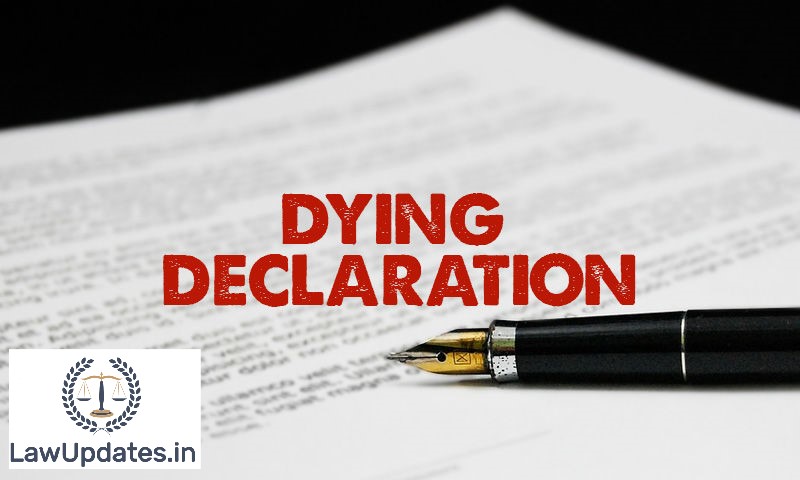A Dying Declaration or Leterm Mortem is a statement made by a person who is unavailable to testify in the court, typically because of his death. Such a statement must be made by the person under the belief of certain and impending death. The statement made must also relate to the person’s belief or knowledge regarding the causes and circumstances of the transaction resulting in such death.
The word “Dying Declaration” is self-explanatory. It is any statement verbal or written, made by a person who is about to die or is dead. Section 32 (1) of the Indian Evidence Act, lays that any statement made by a person just before the event of his death or any statement made earlier which explains the cause of his death is a Dying Declaration. It is admissible because it is based on the general belief that “a dying man does not lie” or “truth sits on the lips of a dying man”. Thus, a person who is conscious and knows that his death is imminent and has no hope of recovery can state the reason for his death and it will be admissible in the court.
Dying Declaration in the form of Gestures and Sign
The apex court in the Nirbhaya rape case made it clear that a dying declaration may not necessarily be in words. Gestures and signs could also form a dying declaration and will be admissible in the court.
The evidentiary value of gestures and signs depend upon factors like who recorded the statement or what were the questions asked. Interpretation of Gestures and signs can be challenging and subject to misinterpretation but merely because the victim was unable to speak, the accused cannot walk away freely.
Acceptable form of Dying Declaration
The question of an acceptable form of dying declaration commonly arises in the court of law. The answer to this question is that there is no specified form of dying declaration that is accepted in the court of law. It can be oral, written, signs, or gestures. It can be in a question-answer format or paragraph. It can also be in any language known by the person. The only thing that is to be taken into consideration is that it must be a functioning piece of evidence with appropriate identification.
Language of the statement
The statement of the declarant should ideally be recorded in the language of the declarant or that of courts. However, the court cannot reject or vitiate the validity of any statement only based on the language. It can be recorded in any language whatsoever. It can be in Hindi, English, Urdu, or Assamese, or any other language and the court cannot challenge its validity. It’s only when the declarant makes a statement in a particular language and the magistrate records it in some other language, precaution is to be taken while reading and explaining every detail of the statement to the declarant. In Biju@ Joseph v. State of Kerala the court held that merely because the declarant made the statement in her language, the court cannot deny the admissibility of such statement.
Incomplete Statement
The Apex Court has held that if a declarant fails to complete his statement regarding important details like the cause or motive for the crime, renders the dying declaration as unreliable. The same does not apply in cases where he has narrated the whole incident and leaves out a few other details. And the declaration can be relied upon.
Multiple Dying Declarations
The Supreme Court has laid that multiple dying declarations can be admitted in the court without corroboration if there is a consistency throughout. If the statements made, vary from each other, the court needs to examine the facts of the case and the statement of other witnesses in the criminal trial to ascertain the truth.
The expectation of death not necessary
The English law says that it is not necessary that the declarant had an immediate expectation of death when he made the statement, to make it admissible. The Indian Evidence Act has taken this law from English law. It is not necessary that the statement recorded was made just before the death of the declarant. In the case of Pakala Narayan Swami v. Emperor, the court held that the statement must have some proximity to the event of the declarant’s death or the circumstances explaining his death, to be relevant under section 32 of the Evidence Act.
FIR as Dying Declaration
If an FIR is filed by an injured person and is followed by his death, such FIR will be considered as a dying declaration. The court in the case of Munna Raja and another v. State of MP also laid that the FIR registered by the dying person need not cover the whole incidence but just the relevant facts. The FIR is considered as a dying declaration and requires no corroboration. It is admissible under section 32 of the Evidence Act and can be the sole purpose for conviction.
When the declarant Survives
A statement is considered as a dying declaration and is admissible in the court only in the event of the death of the declarant. If the declarant does not die, he can act as a witness against the accused in the court. Also, when it appears that the accused did not die of the injuries described in the incident, the statement becomes inadmissible under section 32.
Conclusion
Dying Declaration is one of the most important forms of evidence submitted in the court of law as it can be the sole purpose of conviction of the accused. It is considered so reliable because it is made in the extremity when all hopes of life are gone and the motive of falsehood is left behind. It is believed that a dying man does not lie and therefore faith can rely on his words. It is important to record such statements with utmost precaution and must not be tampered with for fair judgement.
(Author: Shivani Agrawal, pursuing LLB from Faculty of Law, University of Delhi.)




